Artificial Intelligence (AI) is not only the buzzword of 2023 but also a necessity in a fast-evolving tech landscape.
Products like GPT-4, Copilot, Duet AI, and Firefly, among others, are prompting organizations and people to adopt AI rapidly and gain a competitive edge. Educating oneself about AI isn’t an option anymore, it’s the bare minimum.
So, here are 10 fundamental AI terms you should know:
➧ Generative AI: Generative AI is a technology that generates text, images, audio, video, software code, and more, based on user prompts. More technically, generative AI takes massive amount of raw training data, uses deep learning algorithms to recognize patterns, characteristics, and subtleties in it, and produces original content based on that information.
➧ Training Data: After a deep learning model is created, it is fed with as much data as possible to enable it to recognize and learn meaningful patterns. For example, ChatGPT was trained on the Common Crawl, a publicly available collection of billions of web pages, and mountains of text data, including books, Wikipedia articles, etc.
➧ Machine Learning: Machine Learning (ML) is a subset of AI and a superset of deep learning. It is the branch of computer science that uses automated algorithms to learn data, improve cognition, and provide accurate results.
➧ Deep Learning: Deep Learning is a subset of ML that uses layers and layers of neural networks and algorithms to imitate the functioning of a human brain. It is trained on billions of data points and is well-suited to solve real-world questions and problems.
➧ Natural Language Processing (NLP): As you know, generative AI models provide output based on user prompts. NLP combines the power of linguistics, computer science, and ML to enable computers to understand human input and respond accordingly, facilitating conversations between man and machine.
➧ Large Language Models (LLMs): Large Language Models power generative AI. LLMs are deep-learning models that utilize several NLP algorithms and massive datasets to understand, manipulate, and generate content.
➧ Chatbot: Chatbots like ChatGPT and those in Microsoft Copilot and Google Duet AI use natural language processing to understand user questions and provide relevant, automated responses.
➧ GPT-4: Created by OpenAI, Generative Pre-trained Transformer 4 (GPT-4) is an LLM that powers the premium version of ChatGPT. GPT-4 is more reliable, creative, intuitive, and intelligent than its predecessor (GPT-3.5). Several companies have adopted GPT-4, including Microsoft with Copilot.
➧ Strong AI and Weak AI: Weak AI, or narrow AI, automates specific tasks like answering questions, playing games, generating content, etc. Despite its name, weak AI is powerful, however, it operates under several constraints. All the AI that exists today is weak. Strong AI doesn’t exist yet; it is a hypothetical, future version of AI that will think and act like human beings.
➧ AI Ethics: AI ethics is a moral framework that informs the responsible development and use of AI. Companies may use these principles to create AI tech that benefits society as a whole.
AI is evolving at a rapid pace and changing the way organizations and humans operate. There’s still a lot to learn, but knowing these terms will empower you to participate in informed discussions, make strategic decisions, and shape the application of AI in your industry.
Interested in harnessing AI to transform your organization?
Get in touch at india@noventiq.com, and our team of experts will help you integrate AI technologies into your ecosystem to significantly enhance efficiency, collaboration, creativity and productivity.








